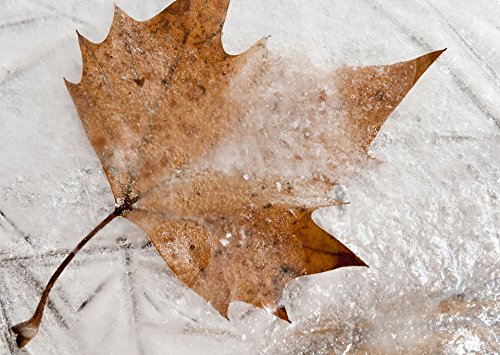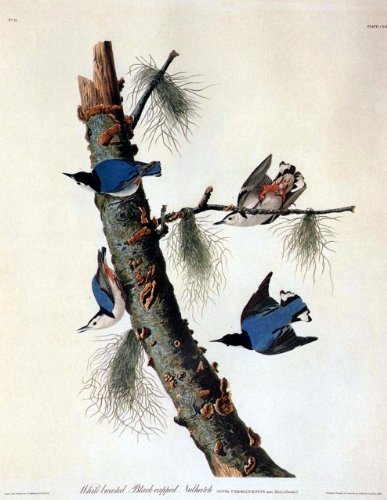Still colder this morning, 7° at 8.30 am.
To Walden.
I walk in the bare maple swamps and detect the minute pensile nests of some vireo high over my head, in the fork of some unattainable twig, where I never suspected them in summer -- a little basket cradle that rocked so high in the wind. And where is that young family now, while their cradle is filled with ice?
I was struck today by the size and continuousness of the natural willow hedge on the east side of the railroad causeway, at the foot of the embankment, next to the fence. Some twelve years ago, when that causeway was built through the meadows, there were no willows there or near there, but now, just at the foot of the sand-bank, where it meets the meadow, and on the line of the fence, quite a dense willow hedge has planted itself .
I used to think that the seeds were brought with the sand from the Deep Cut in the woods, but there is no golden willow there; but now I think that the seeds have been blown hither from a distance, and lodged against the foot of the bank, just as the snow-drift accumulates there, for I see several ash trees among them, which have come from an ash ten rods east in the meadow, though none has sprung up elsewhere.
There are also a few alders, elms, birch, poplars, and some elder. For years a willow might not have been persuaded to take root in that meadow; but run a barrier like this through it, and in a few years it is lined with them. They plant themselves here solely, and not in the open meadow, as exclusively as along the shores of a river. The sand-bank is a shore to them, and the meadow a lake.
How impatient, how rampant, how precocious these osiers! They have hardly made two shoots from the sand in as many springs, when silvery catkins burst out along them, and anon golden blossoms and downy seeds, spreading their race with incredible rapidity. Thus they multiply and clan together. Thus they take advantage even of the railroad, which elsewhere disturbs and invades their domains.
May I ever be in as good spirits as a willow! How tenacious of life! How withy! How soon it gets over its hurts! They never despair. Is there no moisture longer in nature which they can transmute into sap? They are emblems of youth, joy, and everlasting life. Scarcely is their growth restrained by winter, but their silvery down peeps forth in the warmest days in January.
The very trees and shrubs and weeds, if we consider their origin, have drifted thus like snow against the fences and hillsides. Their growth is protected and favored there. Soon the alders will take their places with there. This hedge is, of course, as straight as the railroad or its bounding fence.
Over this crust, alder and birch and pine seeds, etc., which in summer would have soon found a resting place, are blown far and wide. (1856)
-
1850
- Oct 15, 2019 October 14
- Oct 1, 2019 October 1
- Sep 9, 2019 September 9
- Aug 30, 2019 August 30
- Aug 29, 2019 August 29
- Aug 24, 2019 August 24
- Aug 1, 2019 August 1
- Jul 29, 2019 July 29
- Mar 27, 2019 March 27
-
1852
- Oct 13, 2019 October 13
- Aug 18, 2019 August 18
-
1853
- Jun 30, 2019 June 30
- Mar 31, 2019 April 1
- Feb 22, 2019 February 23
- Jan 22, 2019 January 23
-
1854
- Dec 5, 2019 December 5
- Jun 30, 2019 June 30
- Mar 16, 2019 March 17
- Mar 14, 2019 March 15
- Mar 13, 2019 March 14
- Mar 12, 2019 March 12
- Feb 28, 2019 March 1
- Feb 15, 2019 February 16
-
1855
- Mar 13, 2019 March 14
-
1856
- Mar 15, 2019 March 16
- Feb 28, 2019 March 1
- Feb 22, 2019 February 23
- Feb 15, 2019 February 16
- Feb 13, 2019 February 14
- Feb 13, 2019 February 13
- Feb 11, 2019 February 12
- Feb 6, 2019 February 7
- Feb 5, 2019 February 5
- Feb 3, 2019 February 4
- Feb 2, 2019 February 2
- Jan 29, 2019 January 29
- Jan 27, 2019 January 28
- Jan 26, 2019 January 27
- Jan 25, 2019 January 26
- Jan 22, 2019 January 23
- Jan 20, 2019 January 21
-
1858
- May 31, 2019 May 31
-
April 28
- Apr 28, 2022 April 28
-
Ash Trees
- May 20, 2020 May 21
-
August 27
- Aug 27, 2019 August 27
-
Birds
- Apr 28, 2022 April 28
- Feb 26, 2020 February 26
-
Cows
- Aug 22, 2024 June 20
-
December 16
- Dec 16, 2024 Feet and Hands
-
Fate
- Nov 17, 2020 November 17
-
Frogs
- May 20, 2020 May 21
-
Ice
- Feb 26, 2020 February 26
-
June 20
- Aug 22, 2024 June 20
-
Long-Tailed Meadow Mouse
- May 31, 2020 May 31
-
May 12
- May 12, 2022 May 12
-
May 23
- May 23, 2020 May 23
-
May 31
- May 31, 2020 May 31
-
Meadow
- Feb 26, 2020 February 26
-
Metaphysics
- May 20, 2020 May 21
-
Mountains
- Oct 20, 2019 October 20
-
November 17
- Nov 17, 2020 November 17
-
November 18
- Nov 19, 2020 November 18
-
Weather
- Feb 29, 2020 February 29
-
Wind
- Feb 29, 2020 February 29
P.M. - Down railroad. A moist, thawing, cloudy afternoon, preparing to rain.
The telegraph resounds at every post. It is a harp with one string - the first strain from the American lyre.
In Stow's wood, by the Deep Cut, hear the gnah gnah of the white-breasted, black-capped nuthatch. I went up the bank and stood by the fence A little family of titmice gathered about me, searching for their food both on the ground and on the trees, with great industry and intentness, and now and then pursuing each other.
There were two nuthatches at least, talking to each other. One hung with his head down over a large pitch pine, pecking the bark for a long time - leaded blue above, with a black cap and white breast. It uttered almost constantly a faint but sharp quivet or creak, difficult to trace home, which appeared to be answered by a baser and louder gnah gnah from the other. A downy woodpecker also, with the red spot on his hind head and his cassock open behind, showing his white robe, kept up an incessant loud tapping on another pitch pine.
All at once an active little brown creeper makes its appearance, a small, rather slender bird, with a long tail and sparrow-colored back, and white beneath. It commences at the bottom of a tree and glides up very rapidly, then suddenly darts to the bottom of a new tree and repeats the same movement, not resting long in one place or on one tree.
These birds are all feeding and flitting along together, but the chickadees are the most numerous and the most confiding. I cannot but think that this sprightly association and readiness to burst into song has to do with the prospect of spring -- more light and warmth and thawing weather. (1854)



